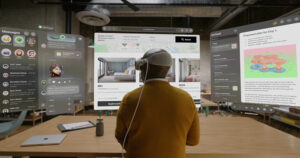One of the most important technology trends in higher education is the growing use of 4K visual displays, which transform an ordinary classroom, student center, or e-sports arena into a fully immersive student experience.
According to a 2023 survey by WGU Labs and the College Innovation Network, two-thirds of higher education instructors anticipate using more technology over the next three years. This trend indicates that high-end audio-visual (AV) technology will continue to expand in classrooms. The report found that 82% of respondents believe that access to technology directly impacts student engagement.
For example, professors can envelop their students in the day’s lesson with 360° projections of vibrant imagery. Imagine being an art history student surrounded by Picasso’s portfolio of works while sitting at your desk.
That quality of surround visual immersion is no longer reserved for high-end academic and entertainment venues. It is also cropping up in corporate and dynamic worship service settings.
To meet those needs, Panasonic Connect in June announced an expansion of its AV Solution Suite at InfoComm 2024. The company plans to power innovative and engaging visual experiences across industries.
“As more industries seek to implement immersive visual experiences, they will need to adopt reliable, powerful solutions that give content creators and production teams flexibility,” said Jared Darensbourg, director of sales for Visual Systems at Panasonic Connect.
The latest additions to its ecosystem of AV solutions respond directly to this industry need, he offered. These solutions help customers worry less about the technology setup and focus more on how they can take their creativity and audience experience to the next level.
Panasonic Connect AV Solutions for Higher Education
The commercial audio-visual division of Panasonic has been selling high-end projectors and displays to higher education for multiple use cases for the better part of 50 years, along with PTZ cameras for 16 years. These robotic video cameras provide enhanced graphic features that can pan horizontally, tilt vertically, and zoom in on a subject to improve image quality without digital distortion.
The newest models included in Panasonic Connect’s announcement do not need to be controlled by a remote operator. They make broadcast quality affordable and easy to use when integrated with other software technologies for recording and live streaming.
Panasonic Connect fed the frenzy four years ago with wireless microphones as the trend for better visual and audio technologies in college classrooms and lecture halls matured. This year, it is adding its ceiling microphone, according to Petro Shimonishi, director of product management for Panasonic Connect.
“We developed the ceiling microphone with input from close to 80 universities. We traveled and visited a lot of universities about ceiling microphones, what they liked, what they didn’t like, and we came up with some pretty unique features for education,” she told TechNewsWorld.
Panasonic Connect is heavily involved with several higher-education organizations to keep up with high-end educational needs. These organizations include the Higher Ed Technology Managers Association (HETMA), The Edtech Collective at Instructure, and EduCause.
“We leverage a lot of our relationships with higher education to closely understand what their needs are, especially in terms of classroom technology, and then develop products that are specifically suited for the demands of the higher education space,” said Shimonishi.
Post-Covid Improvements Transforming Instructional Images
Covid’s impact on the classroom is driving the adoption of new technology within higher education, according to Shimonishi. Speakers and projectors hanging from ceilings make it easier to create space for some of the other products getting installed.
The big difference in post-Covid education is that college students’ expectations for hybrid remote education are a priority. Experiences with audio-visual technology are now vastly different between K-12 and higher education.
While remote learning was largely unsuccessful below college, we are seeing the expectation of college and university students wanting to retain that capability. They want to take a class anytime, anywhere, Shimonishi observed.
“Some universities were telling me that all of their classes are still hybrid. They have students who will sit outside in the quad on the grass, out like 200 feet away from classrooms, and take the class remotely because that’s their expectation, and that’s how they want to learn,” she offered.
Since the hybrid approach in higher education is here to stay, better cameras and microphones for capturing teachers and students are necessary. With Panasonic’s software, the teacher comes in, hits a button on the touchscreen, and the system instantly recognizes the teacher as the image to follow around the room.
Adopting High Tech Has Added Benefits
In cases where AV integrity is essential, tech items, such as high-quality ceiling microphones and 4K cameras, make audience engagement work. For instance, if a student or assistant walks in front of the teacher to hand out materials, the ceiling camera does not get confused. This clarity provides remote students with a much more engaging experience.
“It is just a carryover from Covid in higher ed. We see more universities, even on the community college level, are installing this type of equipment,” Shimonishi said. Perhaps it is an unexpected consequence. One of these is improved student recruiting.
“When parents visit colleges, the number one thing they want to know about is the education program. Since so many of us use technology in our day-to-day lives, having a good classroom technology suite is a recruiting mechanism for many of these universities,” she suggested.
For instance, Kairos is a live production platform that provides unlimited control to deliver rich content for broadcast, large screen display, and live streams in 4K HDR. It adds the ST 2110 standard baseband and streaming connectivity for input/output flexibility. This feature allows for both local and remote contributions to content creation.
Upgrading Audio-Visual Experiences
Several new projectors augment the Kairos platform for a new level of optimum presentation success. These include:
PT-REQ15/REZ15 Series 1-Chip DLPTM 4K Projectors

Produce smooth, deep 4K images in any environment. Their optical engine and laser light source module comply with the IP5X Dust Protected standard, while the backup input and multi-laser drive engine allow them to operate reliably in harsh conditions. They are available now.
PT-RQ7 Series 1-Chip DLPTM 4K Projectors

Power deep, vivid content to wrap an entire space, from floor to ceiling, in dynamic visuals. Expected to be available in the second half of 2024.
Media Production Suite

Centralize camera management for small team operations. The Media Production Suite streamlines camera setup and provides a wide range of features to support high-quality video production. The suite brings production value to the PTZ camera portfolio by adding new paid plug-in features such as AI Keying and auto-tracking. Available now as a free download.
ET-FMP50 Series Media Processor

Designed to streamline workflows while supporting enhanced performance, the ET-FMP50 features camera-based warping, blending adjustment, and 4K media playback capability. Expected to be available in the second half of 2024.
“The RQ7 projector is the first 4K projector in a very small form factor with the really high performance for this market,” Shimonishi noted.
The innovative design shrunk the size of a 4K projector — usually around 48 inches — to a much more reasonable size — about 19 inches wide, 17 inches deep, and seven inches tall. That is ideal for classroom installation and does not interfere with ceiling microphones or ceiling speakers, she added.
Editor’s Note: The images featured in this article are credited to Panasonic Connect North America.

























































